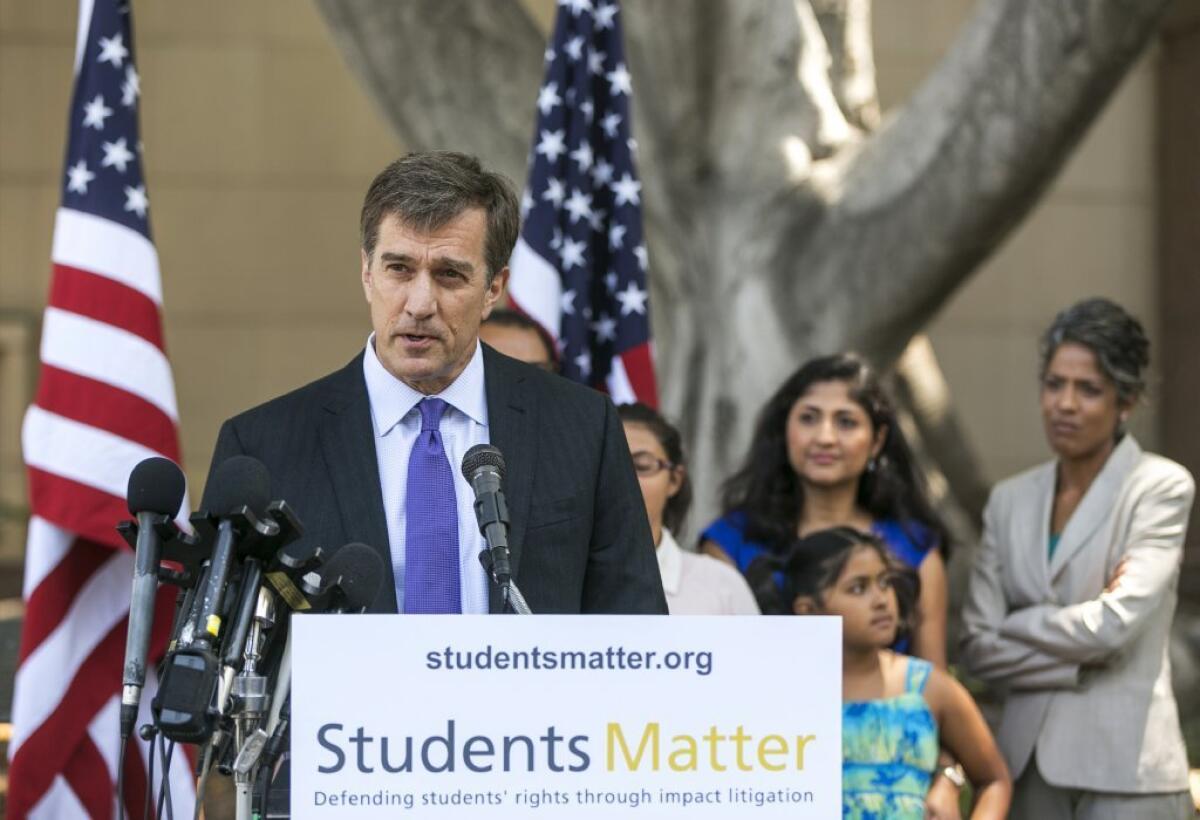Opinion: Chances are, schools can’t fire their way to high-quality education

If we got rid of all the really awful teachers in the schools, that would be a good thing. But, despite a ruling this week striking down several labor laws protective of teachers, it would be a mistake to believe that this is going to magically raise achievement levels in any appreciable way.
The estimates of how many teachers fall into this bottom-feeder category generally range from 1% to 5%. Let’s settle on 3% as a reasonable average, a number that Los Angeles Superior Court Judge Rolf M. Treu seemed comfortable with in his ruling Tuesday.
So, on average, students are likely to have one or two stinkers during their public school careers. This might be especially damaging if it’s in a subject like math, where the skills learned one year are usually necessary for the lessons of the next year. But in general, are one or two bad teachers enough to wreck 13 years of education and the work of more than 40 teachers a student will have during that time?
There are studies that show some significant learning differences, as measured by standardized tests, between the top-performing teachers and the bottom of the instructional barrel. The reality, I suspect, is rarely that stark.
Certainly, I had a couple of the bad ones, and I’m sure you could tell some interesting stories too. I’m remembering the second-grade teacher who bored me to the point where I kept myself busy by secretly reading a book tucked on my lap, and the eighth-grade geology teacher for whom “teaching” meant copying the state curriculum, word for word, on the blackboard each day while we studiously copied it in our notebooks. This meant continual erasing and writing on her part, and I can only imagine how buff the upper-arm muscles were on the right side.
My kids also were assigned to their share of the problem teachers. For eample, the middle school English teacher who assigned papers that she clearly wasn’t reading. The students were so aware of it that one left a note on the third page of his essay: “Mrs. X, if you’re still reading at this point, please initial here.” It came back without the initial. Graded grammar tests would be returned with the multiple wrong answers graded as correct. In another class, the teacher was absent during every heavy rain, but the students learned more from the substitutes anyway.
This shouldn’t be happening, but the principals’ reactions to the many unhappy parents was always that the law made it too hard to fire them. The situation has to change. It shouldn’t take years of tortuous process to get rid of employees who don’t bother to show up and do a job. But I can hardly say that these teachers so thoroughly wrecked students’ academic careers that this was an unconstitutional denial of the right to an education.
It is true that a disproportionate number of weak teachers have traditionally been assigned to the schools of disadvantaged students, the ones most likely to fall irretrievably behind. But that’s not a matter of state law; it resulted from long-standing school district contracts and policies that allowed senior teachers to pick their schools and allowed administrators to transfer the lemons from school to school — usually the ones where parents had the least clout.
From a real-life perspective, perhaps the biggest concern shouldn’t be the extremely few terrible teachers but rather the much larger number of just OK teachers. One in particular sticks in my mind, a fifth-grade teacher in a low-performing Los Angeles Unified school whom I met at a party a few years back. She was talking about the new reading program being introduced at the time, and how some of her students “got it” and others didn’t. She would offer a little extra help to the struggling ones, but nothing out of the way. No after-school or lunchtime sessions to analyze where the problem was. She clearly wasn’t losing any sleep over the fact that a small but significant chunk of her students were floundering; she was making no plans for new approaches she might try to reach them.
Other teachers follow their preset rubrics to grade essays, never actually looking to see whether the writing is good. There are too many classes where the lessons are adequate but boring, where some of the information makes it into the student’s brain while the spark of loving to learn is snuffed out bit by bit over the years.
There are the great teachers too, who fortunately seem more numerous than the worst but not nearly as common as the getting-by sort. These are fairly magical creatures who translate their love of a subject to a classroom full of students and imbue those kids with a sense of excitement about school. They propel students to new heights, and most parents would rather have their children in a class of 32 kids with one of these educational stars than in a class of 20 with a mediocre instructor.
Of course, teachers who don’t do an adequate job shouldn’t be able to use the shield of tenure to hold onto employment until retirement. But if the real issue here is improving education, the much more important questions are how do we hire more teachers with the potential to be stars, and how do we keep them excited about their jobs? And is it possible to help spread their magic to less inspiring teachers who might like to learn those skills and be reinvigorated about their jobs? What’s the fairy dust it would take?
More to Read
A cure for the common opinion
Get thought-provoking perspectives with our weekly newsletter.
You may occasionally receive promotional content from the Los Angeles Times.







